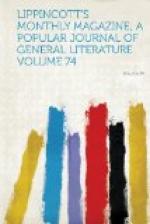“We are now approaching,” he said, “a city which distinguishes itself from those which you have seen by the fact that besides a very rich past it has also a very bright future. It is situated at the southern point of the Lower Doab, whose fertile and richly-cultivated plains you have been looking at to-day. These plains, with their wealth, converge to a point at Allahabad, narrowing with the approach of the two rivers,—the Ganges and the Jumna—that enclose them. The Doab, in fact, derives its name from do, “two,” and ab, “rivers.” But Allahabad, besides being situated at the junction of the two great water-ways of India—for here the Jumna unites with the Ganges—is also equally distant from the great extremes of Bombay, Calcutta, and Lahore, and here centres the railway system which unites these widely-separated points. Add to this singular union of commercial advantages the circumstance—so important in an India controlled by Englishmen—that the climate, though warm, is perfectly wholesome, and you will see that Allahabad must soon be a great emporium of trade.”
“Provided,” I suggested, “Benares yonder—Benares is too close by to feel uninterested—will let it be so.”
“Oh! Benares is the holy city. Benares is the blind Teiresias of India: it has beheld the Divine Form, and in this eternal grace its eyes have even lost the power of seeing those practical advancements which usually allure the endeavors of large cities. Allahabad, although antique and holy also, has never become so wrapped up in religious absorption.”
On the day after our arrival my companion and I were driven by an English friend engaged in the cultivation of indigo to an indigo-factory near the town, in compliance with a desire I had expressed to witness the process of preparing the dye for market.
“Not long ago,” I said to our friend as we were rolling out of the city, “I was wandering along the banks of that great lagoon of Florida which is called the Indian River, and my attention was often attracted to the evidences of extensive cultivation which everywhere abounded. Great ditches, growths of young forests upon what had evidently been well-ploughed fields within a century past, and various remains of settlements constantly revealed themselves. On inquiry I learned that these were the remains of those great proprietary indigo-plantations which were cultivated here by English grantees soon after Florida first came under English protection, and which were afterward mournfully abandoned to ruin upon the sudden recession of Florida by the English government.”
“They are ruins of interest to me,” said our English friend, “for one of them—perhaps some one that you beheld—represents the wreck of my great-great-grandfather’s fortune. He could not bear to stay among the dreadful Spaniards and Indians; and so, there being nobody to sell to, he simply abandoned homestead, plantations and all, and returned to England, and, finding soon afterward that the East India Company was earnestly bent upon fostering the indigo-culture of India, he came here and recommenced planting. Since then we’ve all been indigo-planters—genuine ‘blue blood,’ we call ourselves.”




